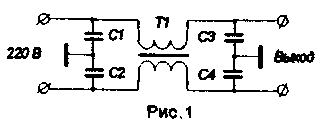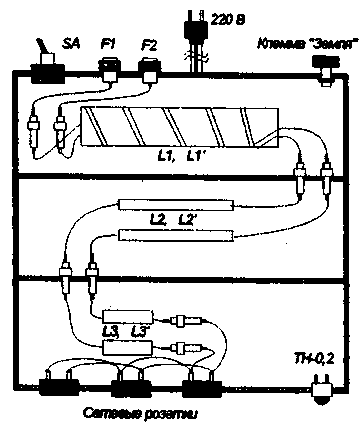
|
|
ENCYCLOPEDIA OF RADIO ELECTRONICS AND ELECTRICAL ENGINEERING Universal mains filter and its design. Encyclopedia of radio electronics and electrical engineering
Encyclopedia of radio electronics and electrical engineering / Protection of equipment from emergency operation of the network Having once plugged the VOLNA-K radio receiver and the Pentagon-128 computer with a disk drive and power supply into the same network socket, it turned out that these devices turned out to be poorly compatible. All computer equipment gave out a powerful and wide range of radio interference, so the poor thing "WAVE" roared almost anywhere in the range from 12 kHz to 23,5 MHz. There were also interferences on TV. All this led to the idea to make and install a surge protector, that. it would not hurt if an amateur radio station was operated, but everything was postponed "for later." The spectrum of interference was very wide and the solution came by analogy with the anode choke in the output stage of a tube power amplifier. Having estimated the efficiency [1] for different frequencies, I realized that the filter should be three-section. The classic version [2] on a ferrite ring, Fig. 1, when winding 10 turns on a 600NN K32x16x6 or 400NN K40x25x7,5 magnetic circuit and capacitors C1 ... C4 = 0,01 μF, showed the worst results. Perhaps due to the low capacitance of the capacitors, which should be at least an order of magnitude greater than 0,1 ... 0,22 uF.
I failed to find pass-through (high-frequency) capacitors of such a capacity. The maximum capacitance of capacitors KTP-3 is 0,015 uF. Paper feedthrough capacitors have large capacitances, but they can effectively suppress mainly low-frequency interference of domestic and industrial origin, penetrating into the radio receiver from the AC mains. Therefore, it was necessary to make a universal surge protector that would not pass high-frequency interference from the network to the radio receiver or transceiver when receiving, and, conversely, to the electrical one when transmitting. The network filter circuit is shown in Fig.2. Details The filter uses capacitors C1 ... C4, C9 ... C12 - KPB - 0,022 μF - 500 V C5 ... C8, C13 ... C14 - KTP-3 - 0,015 μF - 500 V (ceramic, red with M8 thread - 0,75). As can be seen from the diagram, ceramic and paper feed-through capacitors are connected in pairs in parallel. "Neonka" VL1 - an indicator of the inclusion of the filter in the network. Inductors L1 and L1' are wound with a conventional double mains wire, insulated (for example, from a burnt soldering iron) on seven flat ferrite rods stacked together for a magnetic antenna. The total cross section of the magnetic circuit is 4,2 cm2. The rods are tightly stacked on top of each other and wrapped with three layers of varnished fabric. A winding containing seven turns is wound on top of it. The resulting element looks more like a feed-through transformer than a choke, Fig. 3.
Inductors L1 and L1' can also be wound on a ferrite ring with a permeability of 400 - 2000 HN. Its cross section is selected at the rate of 0,25 cm100. per XNUMX W consumed from the power network in order to avoid bias due to the asymmetry of the mains voltage. Data on the cross section of the magnetic circuit are given with some margin. In our case, the power is equal to the maximum (over the cross section) and is
Inductors L2 - 2' and L3 - 3' are wound with PEV-2 wire with a diameter of 1,5 mm. The maximum current is determined by the formula
d - wire diameter, mm j - current density, A / mm2, which can be taken as 4 ... 6 A / mm2. At a current density of 4,5 A / mm2, the maximum current will be
It can be assumed that the filter power can reach 2000 W, since it is calculated with some margin. For normal operation, such power is unlikely to be required, but the filter is made for all occasions. Inductors L2 - 2' are wound on ceramic rods with a diameter of 12 mm and a length of 115 mm until completely filled. Inductors L3 - 3' - frameless, contain 9 turns each and are wound in increments to reduce the interturn capacitance and better protection against the highest frequency pickups on a mandrel with a diameter of 10 mm and a length of 41 mm. The network filter consists of three sections, each of which operates with some overlap in a certain frequency range - L3 - 3' in the high frequency region, L2 - 2' in the medium frequency region, L1 and L1' in the low frequency region. In general, all filter sections take part in the work together. The sketch of the filter is shown in Fig.4. Structurally, the filter is assembled in three shielded sections, which are placed in a metal case 190x190x70 mm. The inductors located in adjacent sections are connected through feed-through capacitors installed on vertical partitions. The chokes are fastened with the help of plexiglass racks 10 mm thick, in which the corresponding holes are drilled or bored.
MPH connectors are used for connection. Shielded network wires from the transceiver and power amplifier are connected to it, and, having a distributed capacitance, further reduces high-frequency interference. The shielding braids of the wires are connected to the "ground" terminal, and the filter (case) itself is grounded with a short thick wire (braid of the RK-3 coaxial cable). The filter is equipped with a conventional mains socket or sockets for connecting household equipment, such as a computer and blocks of its components. The quality of the filter can be briefly described as follows. The Volna-K radio receiver with a connected computer was able to receive amateur radio stations on an indoor antenna, and only individual “beeps” of the computer were heard with levels of no more than 3-5 points. Literature 1. Yu. Roginsky "Shielding in radio devices" 1970 Author: A. Kuzmenko, RV4LK; Publication: N. Bolshakov, rf.atnn.ru
Machine for thinning flowers in gardens
02.05.2024 Advanced Infrared Microscope
02.05.2024 Air trap for insects
01.05.2024
▪ Neanderthals are not only in Africa ▪ Samurai brushing their teeth ▪ Silicon clock, not electronic ▪ Children's shoes with a GPS tracker
▪ site section Voltage converters, rectifiers, inverters. Article selection ▪ article Not one iota. Popular expression ▪ article What is sashimi? Detailed answer ▪ article Manufacture of printed circuit boards. HAM Tips ▪ article The simplest spray gun. physical experiment
Comments on the article: Alexander Thank you, just a simplified calculation method I needed.
Home page | Library | Articles | Website map | Site Reviews www.diagram.com.ua |






 Arabic
Arabic Bengali
Bengali Chinese
Chinese English
English French
French German
German Hebrew
Hebrew Hindi
Hindi Italian
Italian Japanese
Japanese Korean
Korean Malay
Malay Polish
Polish Portuguese
Portuguese Spanish
Spanish Turkish
Turkish Ukrainian
Ukrainian Vietnamese
Vietnamese







 Leave your comment on this article:
Leave your comment on this article: